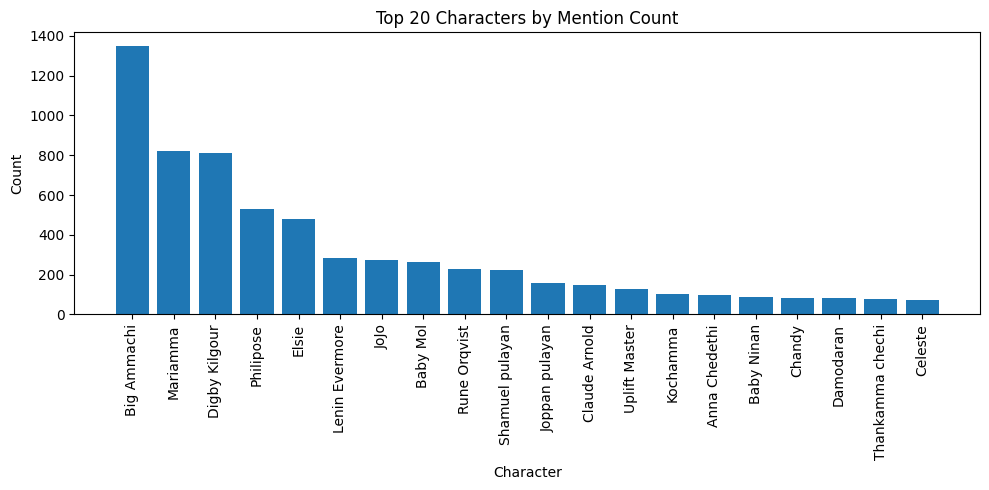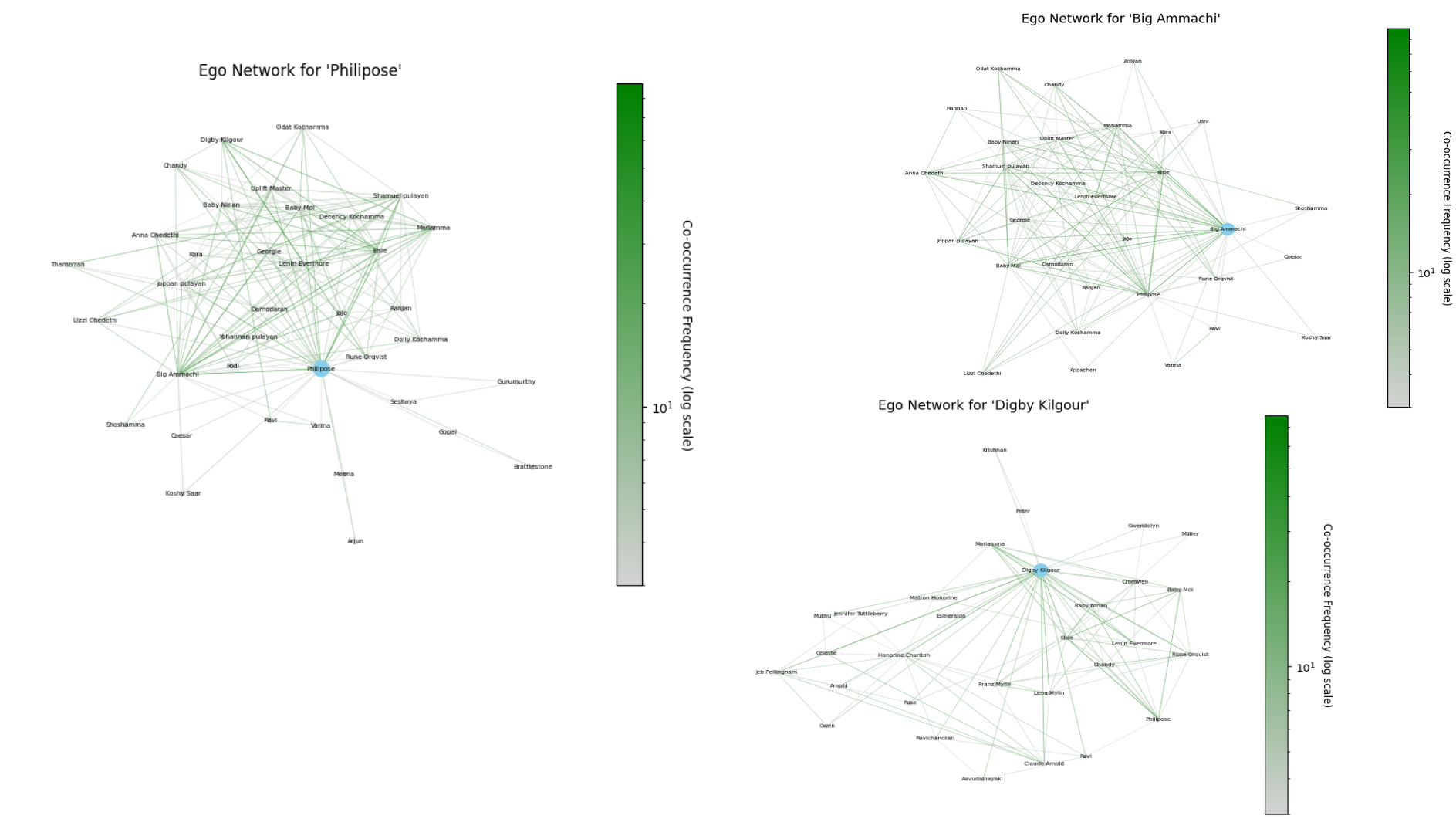Social Network Analysis of The Covenant of Water
Recently I was introduced to the fascinating world of Social Network Analysis (SNA) through Barum Park's course which pushed me to see the world through a different lens. The lens of how people are interconnected with each other and how these connections can be very influential. A world (fictional) that moved me a lot recently is the world built by Abraham Verghese in The Covenant of Water (TCoW). So I decided to use what I had learned from SNA to explore the world of TCoW through nodes and edges. In this article, I have tried not to reveal any spoilers but I think you might enjoy the article more if you have already read the book.
I used a combination of Natural Language Processing (NLP) and SNA to do the analysis. I used the co-occurrence of the character names in a sentence as a proxy for measuring character connections. I know it's a not a perfect measure but I think it's a good proxy for deriving the 'connectedness'. Further, I filtered the connections based on whether a pair of characters have co-occurred at least thrice and if the character in any of the interactions at least twice to be included in the network. If you are interested in the technicalities of how I did it, please refer to the [[#Method]] section at the end of article.
I began my exploration with the classic character count to see how often the character is mentioned in the book.

Not so surprisingly, our matriarch Big Ammachi ruled, followed by Mariamma, Digby, Philipose, and others. It made sense to me given the space that each of these characters occupied in the story. However, things got super interesting when I constructed the network of character connections and analyzed it.

One of the central ideas behind network analysis is that the influence of a particular individual is dependent on who they are connected with and how well they are connected. I intuitively assumed Big Ammachi to be the most influential character in the TCoW world. Big Ammachi is influential but not always. There are other characters more influential than Big Ammachi. Let's dig deeper.
First I measured Degree Centrality[1]. In simple words, which character is most connected to others. I thought it would be Big Ammachi but no it was Philipose. Even though Philipose appeared only fourth in terms of character count, Philipose had the most connections esp. compared to Big Ammachi. Yes, Philipose is a central character but it also makes me wonder if Philipose is more connected with others than Big Ammachi because he's a man and also a writer. Even as per the plot, Big Ammachi left Parambil on very few occasions. While Big Ammachi is centrally connected with everyone in Parambil, her connection with the others in the world beyond Parambil has been limited. Could it be a reason for that? Big Ammachi is followed by Digby. Given Digby's well traveled and sociable personality, I think it makes sense.
Here's the top 10 characters based on Degree Centrality:
| Character | Degree Centrality |
|---|---|
| Philipose | 0.4932 |
| Big Ammachi | 0.4110 |
| Digby Kilgour | 0.3973 |
| Elsie | 0.3288 |
| Mariamma | 0.3014 |
| Shamuel Pulayan | 0.2877 |
| Baby Mol | 0.2603 |
| Lenin Evermore | 0.2466 |
| Uplift Master | 0.2329 |
| Honorine Charlton | 0.1918 |
The Ego networks of Philipose, Big Ammachi, and Digby gives an interesting insight into their connections.

Then I went on to measure Betweenness Centrality[2]. Basically, how much a character connects two other characters who might not get connected otherwise. And guess what, Digby topped the chart. I think it makes sense given the nature of Digby's character (a well travelled Scottish Doctor). He's been part of very distinct groups who might never meet unless Digby makes it happen. In case of Big Ammachi, she stands fourth. Given the provincial nature of Big Ammachi who is influential in Parambil where almost everyone knows each other. I think it makes sense. On that note, Mariamma stands before Big Ammachi in this measure, given that she travelled beyond Parambil for her education and scaled new mountains. Is Philipose behind Digby but before Mariamma because he's a male writer? This needs more investigation.
| Character | Betweenness Centrality |
|---|---|
| Digby Kilgour | 0.3413 |
| Philipose | 0.3029 |
| Mariamma | 0.1418 |
| Big Ammachi | 0.0928 |
| Elsie | 0.0828 |
| Lenin Evermore | 0.0798 |
| Rune Orqvist | 0.0746 |
| Uplift Master | 0.0613 |
| Baby Mol | 0.0456 |
| Shamuel Pulayan | 0.0345 |
Then I measured Eigenvector Centrality [3]. It's a measure of a character's influence, considering not just their direct connections, but also how well-connected their direct connections are. I think this is a super interesting measure and it revealed very interesting findings. Characters like Baby Mol, Elsie, and Shamuel had more eigenvector score than Digby. Same with Big Ammachi as well. Even though these characters didn't venture out of Parambil much, they were directly connected to very influential characters who had a lots of connections. For instance, Elsie is directly connected to Digby, Philipose, Big Ammachi, and Mariamma. Same for Baby Mol and Shamuel as well. I think it's an interesting way to think about influence where one might not have direct influence over something, they might have direct connections with powerful individuals which in turn could give them power. It reminded me of the The Diversity-Bandwidth Trade-off which challenged the famous The Strength of Weak Ties by arguing that stronger ties (despite fewer) can yield benefits than having just lots of weaker ties.
| Character | Eigenvector Centrality |
|---|---|
| Philipose | 0.3306 |
| Big Ammachi | 0.3117 |
| Elsie | 0.2789 |
| Baby Mol | 0.2504 |
| Mariamma | 0.2499 |
| Shamuel | 0.2498 |
| Uplift Master | 0.2205 |
| Baby Ninan | 0.2190 |
| Lenin Evermore | 0.2014 |
| Joppan Pulayan | 0.1929 |
The Ego Networks of Elsie, Baby Mol, and Shamuel

Finally, I measured triads which is basically the number of triangles formed by a character with other two characters. Not so surprisingly, the Parambil folks dominated this given their closely linked connections with each other and their sense of community.
| Character | Triangles |
|---|---|
| Philipose | 130 |
| Big Ammachi | 120 |
| Elsie | 104 |
| Shamuel Pulayan | 90 |
| Baby Mol | 83 |
| Mariamma | 80 |
| Digby Kilgour | 70 |
| Uplift Master | 64 |
| Baby Ninan | 63 |
| Lenin Evermore | 56 |
More interesting stats from the analysis
| Metric | Meaning |
|---|---|
| Number of Nodes (74) | Total unique characters. |
| Number of Edges (271) | Total unique character pairs that co-occur at least once. |
| Density (0.1003) | Only ~10% of all possible connections exist — the network is relatively sparse. |
| Avg. Clustering Coeff. (0.78) | High — characters' friends are often friends with each other (tight clusters). |
| Transitivity (0.40) | Moderate — globally, about 40% of character triangles actually close. |
| Connected Components (1) | Entire network is connected — no isolated groups. |
| Largest Component Size (74) | Same as number of nodes — confirms all characters are part of one network. |
| Triangles (496) | 496 groups of 3 characters who are all connected — suggests tight-knit groups. |
| Avg. Shortest Path (2.42) | On average, any two characters are separated by ~2.4 steps — relatively "small world." |
I asked ChatGPT to interpret the data. Here's what it gave me:
🔍 Character Observations
- Philipose is a central hub in all dimensions — most connected, most influential, most embedded. Likely the main character or a key protagonist.
- Big Ammachi is very central and embedded but less of a bridge — possibly a matriarch or stabilizing force.
- Digby Kilgour has the highest betweenness — a connector or outsider who links groups.
- Elsie, Mariamma, and Baby Mol are also highly central in various dimensions, suggesting strong social roles.
- Shamuel Pulayan and Uplift Master are moderately connected, possibly part of a secondary tier.
- Characters like Honorine Charlton or Rune Orqvist are on the periphery — connected, but not major players.
It's very possible that ChatGPT might already have the entire plot in it's training data. But still it's super interesting how networks can say a lot about the world (both real and fictional). This makes me wonder if network analysis of the fictional literary works could reveal some interesting characteristics of the “real world”.
It might be interesting to see if the centralities of the characters varies between the literary works across regions/cultures at a scale, and if it can help us in understanding the variations our social worlds better.
Coming back to TCoW, I don't know if it was the author's conscious decisions that resulted in the character connections that we see or it's just the reflection of the real world that would come out regardless of the positionality of the author. Despite being the core character of the story, Big Ammachi was overshadowed by Philipose in terms of the social network. Does it reflect the nature of being an women in an Indian society? I am not raising this question as a judgement call. Of course, a person can be incredibly valuable to a community as seen in case of Big Ammachi's character. However, can Big Ammachi still be influential beyond Parambil? And is it even needed to be influential beyond one's own community? So many questions to explore! :)
For the Nerds
Here's a short explanation of how I did the analysis:
Method
- Used
ebooklibto extract the book content from the EPUB copy of the book - Used
spacyto extract the Names from the text using NER - Manually cleaned the character names dataset to account for the variations in the names and aliases. Also removed place names and similar irrelevant names.
- I used the cooccurrence of the characters in a same line as a proxy for measuring character connections. Not a perfect measure but I think it's a decent proxy.
- For a character to be considered connected, there should be connected at least twice
- For a character to be included in the Social Network, they should appear at least twice
- Used
NetworkXfor doing the Social Network Analysis
Code is here in case you want to run it on the novels that you like: https://github.com/ddeepak95/social-network-analysis-novels
A network measure that shows which node is more connected to other nodes in the network, relative to the total possible connections is Degree Centrality. ↩︎
Betweenness Centrality measures how often a node acts a bridge in connecting two other nodes. ↩︎
Eigenvector Centrality measures how well-connected a nodes connections are. ↩︎